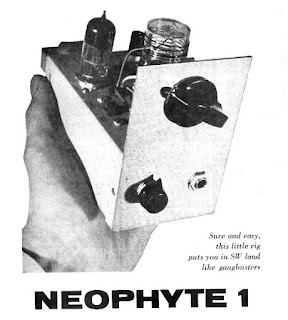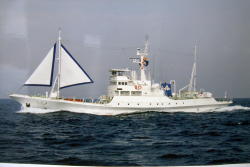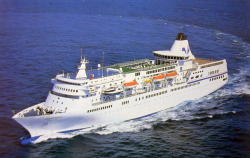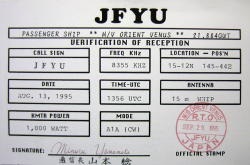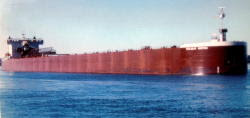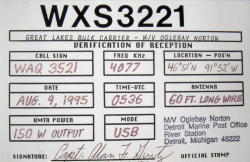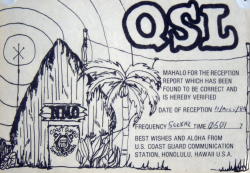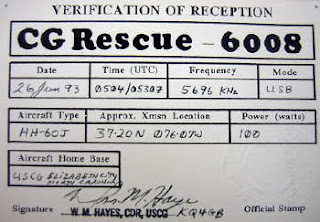Posts Tagged ‘shortwave’
 Solar Cycle 25, and a Life-Changing Event (Part 1 of 2)
Solar Cycle 25, and a Life-Changing Event (Part 1 of 2)
From the RAIN HamCast episode #56, 2021-XII-11 (used with permission):
When you were knee high to a grasshopper, did you undergo a game-changing experience that shaped your future career?
Here is text from the introduction:
Tomas Hood/NW7US did. Tomas has been a shortwave enthusiast since 1973. He was first licensed as a ham in 1990 at age 25.
In the mid 1990s Tomas launched the first civilian space weather propagation website, HFRadio.org, which later spawned SunSpotWatch.com. His website, NW7US has been up and running since June, 1999. Tomas has contributed to the Space Weather Propagation column in CQ magazine for over 20 years, and for The Spectrum Monitor magazine since 2014.
A product of the Pacific northwest, Tomas resides today in Fayetteville, OH. RAIN’s Hap Holly/KC9RP spoke with Tomas recently about Solar Cycle 25 and the game-changing afternoon Tomas experienced in 1973 at age 8 ( Read more about this, at his amateur radio and space weather blog: https://blog.NW7US.us/ ).
Here is the first part of the two-part interview:
Mentioned in the interview is Skylab:
From Wikipedia’s article on Skylab: Skylab was the first United States space station, launched by NASA, occupied for about 24 weeks between May 1973 and February 1974. It was operated by three separate three-astronaut crews: Skylab 2, Skylab 3, and Skylab 4. Major operations included an orbital workshop, a solar observatory, Earth observation, and hundreds of experiments.

Tomas was drawn into space weather as a life-long passion, by inspiration from Skylab, and from the hourly propagation bulletin from the radio station WWV.
WATCH FOR THE NEXT EPISODE, PART TWO
This video is only part one. The RAIN HamCast will conclude Hap’s conversation with Tomas in RAIN HamCast #57, scheduled for posting Christmas Day.

Hap Holly, of the infamous RAIN Report (RAIN = Radio Amateur Information Network), is now producing The RAIN HamCast. The results are both on https://therainreport.com and on the RAIN HamCast YouTube channel, https://www.youtube.com/channel/UCUbNkaUvX_lt5IiDkS9aS4g
KEEP ON HAMMING!
The RAIN Hamcast is produced and edited by Hap Holly/KC9RP; this biweekly podcast is copyright 1985-2021 RAIN, All rights reserved. RAIN programming is formatted for Amateur Radio transmission and is made available under a Creative Commons license; downloading, sharing, posting and transmission of this ham radio program via Amateur Radio in its entirety are encouraged. Your support and feedback are welcome on https://therainreport.com. Thanks for YouTube Technical Assistance from Tom Shimizu/N9JDI.
 New Antenna: The Following Footprints Are of My CW Signals (2021-March-14 @ 04:00 to 04:20 UTC).
New Antenna: The Following Footprints Are of My CW Signals (2021-March-14 @ 04:00 to 04:20 UTC).
The following footprints are of my CW signals on 2021-March-14 at about 04:00 to 04:20 UTC.
Click on this image to see a larger version of this image:
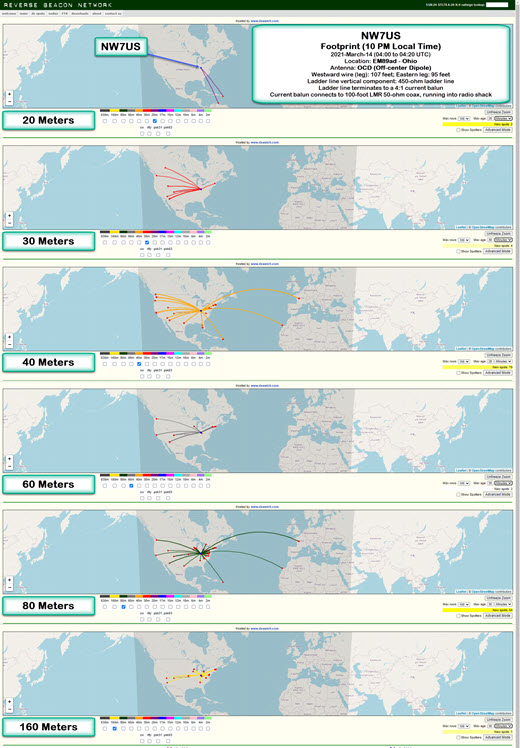
Location: EM89ad – Ohio
Antenna: OCD (Off-center Dipole)
Description of Antenna:
This is an off-center dipole, with the two legs running East-East-South (approximately 125 degrees of North), and West-West-North (about 306 degrees on the compass). The westward wire (leg) is approximately 107 feet in length, while the eastward leg is about 95 feet in length.
These legs (an off-center-fed dipole) is directly connected to about 90 feet of 450-ohm ladder line, which is hanging directly below, vertically, the feed point. The feed point is 50 feet above the ground.
The ladder line terminates (at the 12-feet-above-ground point) to a 4:1 current balun. This current balun then connects to a 100-foot LMR 50-ohm coax, which is running into the radio shack. It is connected via an antenna switch to my Icom IC-7610 transceiver. I am transmitting a 100-watt CW signal using an Icom IC-7610, in the following format:
TEST TEST TEST DE NW7US NW7US NW7US
The Reverse Beacon Network reports any spotting of this test transmission. The beta mapping interface, at http://beta.reversebeacon.net/main.php, then maps the resulting spots. To learn more about the RBN, visit http://beta.reversebeacon.net/index.php, or, http://reversebeacon.net/index.php.
I show the 20-, 30-, 40-, 60-, 80-, and 160-Meter band footprints.
I’ve been capturing these CW transmission spots, at different times of the day, today. I’ll get data from several days, at regular intervals, and create a overview of how the antenna appears to be working during this month and under these propagation conditions.
73 de NW7US dit dit
..
 Just Get On The Air! (A Makeshift Temporary Dipole Shortwave Antenna)
Just Get On The Air! (A Makeshift Temporary Dipole Shortwave Antenna)
It might not take as much antenna as you may think would be necessary to make two-way contacts on shortwave radio (as an amateur radio operator putting an HF transceiver on the air). However, often, makeshift antennae are effective enough to be viable–just look at all the contacts many amateur radio operators make with their low-power (QRP) rigs (transceivers) using short, helically-wound, mobile antenna sticks. If they can work magic with such inefficient antenna setups, surely your effort at an antenna would pay off to some degree. Right?
Of course, I want to make a proper dipole out of this example antenna. But, while I wait for the rest of the parts I need to complete this antenna project (pulleys and a ladder, and maybe a potato launcher), I’ve put this makeshift antenna on the air, with it just high enough so that I can enjoy some time on the shortwave bands.
With this antenna, I’ve made successful two-way voice and Morse code contacts (QSOs) with stations in Europe and across North America. I am able to tune it on the 60-, 40-, 30-, 20-, 15-, 17-, 12-, and 10-Meter bands. Reverse beacon detection picks up my Morse-code CW signals, especially on 40 meters (the band on which it is tuned physically).
The bottom line: just get something up in the air and start communicating. Improve things over time. You’ll have much fun that way.
73 de NW7US dit dit
 NEOPHYTE Adventures
NEOPHYTE Adventures
I've just added a new page to my website, The VE7SL Radio Notebook, that describes my NEOPHYTE 1 regenerative receiver spring construction project. The new page can be found here.
Like most simple regens, its performance far exceeds its simple circuit expectations. My listening adventures with it continue during The Radio Board's annual Homebrew DX Contest which runs from July 11 - 24th. You may want to give it a try, after of course, you've checked-out my new web page!
 DXing The Utilities (Part 2)
DXing The Utilities (Part 2)
**************************************
Unlike the growing scarcity of good HF maritime DX targets, there is still a large amount of HF aero activity to enjoy! Even with the move to satellite comms, there is still, at any given time of the day or night, hundreds of aircraft using HF radio to communicate with controllers, companies and home bases. Both commercial aviation and the military, as well as many privately owned aircraft, use the HF communication networks to keep them flying safely. From trans-oceanic 777s' and military transports to single engine float planes in the Canadian Arctic and Alaska, the sky is alive with DXing opportunities!
A huge percentage of commercial aircraft are delegated to moving freight and many of them can be heard on HF radio. Many of the planes in use are retired passenger planes that have been reconfigured for moving cargo. Back when I did this type of listening, older DC-8s seemed to be particularly popular, especially on the nightly South / Central America to Florida routes. I suspect that nowadays, these have been replaced with older DC-10's and 747's.

'FINE AIR 432' was logged on March 24,1996 at 0435Z while working Miami Radio on 6637kHz. The DC8-51F (Freighter) was over Bogota while enroute from Lima to Miami.
 'NIPPON CARGO 083', a 747-200F, was logged
'NIPPON CARGO 083', a 747-200F, was loggedon 8891kHz working Baffin Radio. They were reporting position "LT", a waypoint above Alert, at 82-31N / 62-12W, westbound on Polar Track "Quebec".
The freighter was enroute Amsterdam to Anchorage.

The Antonov 124-100 is a gigantic Russian built freighter - capable of transporting in excess of
120 tons. This is aircraft "RA-82045" which was logged as 'HEAVYLIFT 878' in June, 1996.
Operated by Volga-Dnepr, 'HEAVYLIFT 878' was working Dakar (Senegal) Aeradio on 6535kHz reporting FL240 and position 13-14N / 24-26W enroute Cape Verde Islands to Sao Paulo, Brazil.
'AFM 01' was a DC8-55F logged while working Brazzaville Radio (Congo) on 8903kHz. It was at FL350, enroute Harare, Zimbabwe to Kano, Nigeria at the "MPK" waypoint, 250 miles east of Kinshasha, Zaire. Brazzavile was advising of 'crossing traffic, same level...please say intentions'... Yikes!
On another evening I heard the Dakar (Senegal) controller advise a British Speedbird 747 to 'go to flight level 330 ... please go now ... go very very fast'.
'AFM01' (Affretair) was Z-WMJ, shown here on final approach to Gatwick.
 'PACIFIC AIR EXPRESS 3517' was heard on 8867kHz working Brisbane Radio while over the Coral Sea. The Lockheed L-188C four-engine turbo prop was enroute Honiara to Brisbane with a load of fresh tuna destined for the Japanese market. N360Q, shown on the ground at Honiara, was leased from the states and operated by Charrak Air.
'PACIFIC AIR EXPRESS 3517' was heard on 8867kHz working Brisbane Radio while over the Coral Sea. The Lockheed L-188C four-engine turbo prop was enroute Honiara to Brisbane with a load of fresh tuna destined for the Japanese market. N360Q, shown on the ground at Honiara, was leased from the states and operated by Charrak Air. The U.S. military is still active on HF radio and some interesting catches can be had. During the testing phase of the 'cruise' missile, the missile navigation systems were tested over the Northern Territories and Alberta. Once dropped from their B-52 launch platforms, the missiles were tracked across Alberta by Advanced Range Instrumentation Aircraft (ARIA). 'AGAR 93' was heard on one such mission on 11176kHz. 'AGAR 93' was # 81-0893, an EC-18 (modified Boeing 707) out of Wright Patterson' 4950th Test Wing. According to the aircraft commander who signed my verification, the aircraft was approximately 1 hour S.E. of Namao, Alberta. One can easily see why # 81-0893, shown here, was affectionately known as "The Beast".
The U.S. military is still active on HF radio and some interesting catches can be had. During the testing phase of the 'cruise' missile, the missile navigation systems were tested over the Northern Territories and Alberta. Once dropped from their B-52 launch platforms, the missiles were tracked across Alberta by Advanced Range Instrumentation Aircraft (ARIA). 'AGAR 93' was heard on one such mission on 11176kHz. 'AGAR 93' was # 81-0893, an EC-18 (modified Boeing 707) out of Wright Patterson' 4950th Test Wing. According to the aircraft commander who signed my verification, the aircraft was approximately 1 hour S.E. of Namao, Alberta. One can easily see why # 81-0893, shown here, was affectionately known as "The Beast".'DOOM 81' was a gigantic B-52H from the 96th Bomb Squadron, stationed at Barksdale AFB, LA. The appropriately named big bomber was heard on 11176kHz while working Ascension Radio and was just about to rendezvous with their mid-air refueler when the mission was aborted. This was the first and only B-52 that I was ever able to confirm.
 'ROMA 99' was logged on 17975kHz while working Thule Radio. They were taxiing for takeoff at Dulles International in Washington D.C. and reporting a minor fuel-pump problem. 'ROMA 99' was a KC-135R Stratotanker, # 62-003512, from the 509th Air Refueling Squadron at Griffis AFB, NY.
'ROMA 99' was logged on 17975kHz while working Thule Radio. They were taxiing for takeoff at Dulles International in Washington D.C. and reporting a minor fuel-pump problem. 'ROMA 99' was a KC-135R Stratotanker, # 62-003512, from the 509th Air Refueling Squadron at Griffis AFB, NY.'REACH 71839' was heard on 11176kHz while working Albrook AFB, Alaska. Tail # 65-0239, this 'REACH' flight was an aging C-141B Starlifter, at one point, the Air Force's major transporter. 'REACH 71839', out of McChord AFB, was enroute Brazil to Puerto Rico.
There's still plenty to be heard on HF, outside of the amateur bands and a quick internet search on 'Utility DX' will turn up several interesting and informative sites ... each one having an abundance of related links to follow. Here are some that will be helpful:
**************************************
A freshly updated list of all active HF aero frequencies. Also check their list of active aero 'callsigns'
http://monitor-post.blogspot.ca/p/this-international-hf-aero-frequency.html
If you can catch an aircraft's four-letter SELCAL code, often given during waypoint checks, you can search here for more info on the actual aircraft itself:
http://www.airframes.org/reg/b18305
The Milcom Blogspot:
http://mt-milcom.blogspot.ca/
 DXing The Utilities (Part 1)
DXing The Utilities (Part 1)
The following blog was originally posted in 2015 but might still be of interest to anyone with a shortwave radio! Although maritime CW has all but vanished from HF, ships can still be logged and followed on digital modes, using DSC or Digital Selective Calling.
*******************************
 After building the house here on Mayne Island, in the early 90's, it was several years until I was able to set up a dedicated station. In the meantime, I limited my radio activities strictly to listening. I had a nice Icom R-71A set up in a hall closet and spent my radio-time, mostly on weekend evenings, listening to maritime CW, HF aeronautical traffic and, of course, NDBs below the broadcast band.
After building the house here on Mayne Island, in the early 90's, it was several years until I was able to set up a dedicated station. In the meantime, I limited my radio activities strictly to listening. I had a nice Icom R-71A set up in a hall closet and spent my radio-time, mostly on weekend evenings, listening to maritime CW, HF aeronautical traffic and, of course, NDBs below the broadcast band.My HF receiving antenna consisted of three inverted-V's ... one for 160m, the second for 80m and the third for 40m ... all fed from the same coaxial line at the top of a 70' Balsam. It didn't take long to realize what an exceptional radio location I had, living right at the edge of the ocean, with dozens of miles of saltwater in most directions other than due west.
I really enjoyed following evening airline flights across both the North and South Atlantic, and in the early winter afternoons, following the commercial air-traffic all over Africa. Even though listening on 5 or 6MHz, I was amazed at how strong the signals from airliners over Africa at 30,000 feet or more could become, this far to the west. In the early mornings, directions were reversed and traffic from the far east, right into India, was fairly common. Often, small single-engine planes, usually run by various missionaries, could be heard while on the ground, taxiing at remote field locations and calling in via HF radio to request takeoff and flight-following.
Now QSL's have always been one of my top radio interests and it wasn't long before I started sending and collecting verifications for both the aircraft and the ships I was hearing ... once I had figured out how to get my reception reports to their proper destinations.
A very small portion of my 'utility' QSL collection is shown below. For the most part, it consists of PRC's or 'Prepared Reply Cards', with blank portions to be filled-in by the verification signers. Surprisingly, my return rate was around 90% and verifications were often returned with long, hand-written letters and numerous photographs ... especially from the ship RO's, as I suspect their days at sea were often quite monotonous. Even many of the military and commercial aircraft pilots would return a handwritten note along with the filled-in verification card, which I found even more surprising. It seemed that most were very surprised to hear that their radio transmissions were even making it this far and could be heard so readily.
 Some of the most interesting catches came from the Pacific, with a large variety of ships operating out of Japan. There are probably still several maritime CW stations operating in Japan. Many of these were owned and operated by commercial fishing companies and could be heard working fleet vessels throughout the Pacific on their daily CW skeds.
Some of the most interesting catches came from the Pacific, with a large variety of ships operating out of Japan. There are probably still several maritime CW stations operating in Japan. Many of these were owned and operated by commercial fishing companies and could be heard working fleet vessels throughout the Pacific on their daily CW skeds.This interesting catch from the North Pacific was the Japanese 'fisheries research vessel' 'M/V FUJI MARU'. She was about 1200 miles NW of her CW contact, JNA in Tokyo.
A Japanese cruise-ship, the 'M/V ORIENT VENUS' was logged early one summer morning while working JNA on 8355 KHz CW. Her position indicates she was in the Mariana Islands.
One of my first catches from the Great Lakes
was the 'M/V Oglebay Norton', a huge bulk
carrier out of Detroit. Her 150W signal was loud and clear late one August evening while in contact with WLC, Rogers City Radio.
 The U.S. Coast Guard is still one of the best QSLers around.
The U.S. Coast Guard is still one of the best QSLers around.Several of their stations will QSL with a nice printed card.
NMC (San Francisco) and NMO (Hawaii) were two
catches, regularly heard on the old 500 KHz calling
frequency.
Stormy weather often provided a good chance
to catch a search and rescue mission in progress.
'Rescue 6008' was an HH-60J helo enroute from
Chesapeake Bay to Elizabeth City, North Carolina during
a midnight rescue operation.

Although not my farthest HF maritime catch,
this was one of the most surprising. 'C4PC'
was heard early one February evening on 8 MHz CW, when conditions seemed terrible. No other ships were heard on the band at the time. As I learned later, the 'M/V MAIROULI' was at anchor near Beirut, Lebanon, a distance of nearly 7,000 miles from Mayne Island.
.... cont'd
 Olivia Digital Mode (1000 Hz) on Twenty Meters – A Simple Video
Olivia Digital Mode (1000 Hz) on Twenty Meters – A Simple Video
The Olivia digital mode on HF radio is a mode capable of two-way chat (QSO) communication (keyboard to keyboard, like RTTY) over long-distance shortwave (HF) ionospheric propagation paths, especially over polar regions.
If you are interested in more than a logbook QSO (such as is typical with FT8 and other propagation-checking modes) but want to chat with other hams around the world using digital modes, consider Olivia as one option.
This video captures a few moments of two-way conversation on the Twenty-Meter band, up in the sub-band where 1000-Hz digital modes are commonplace. More narrow-bandwidth settings are used in a lower subband in the digital slice of Twenty Meters. More details about the mode are in the files section of this website: http://OliviaDigitalMode.org.
In 2005, SP9VRC, Pawel Jalocha, released to the world a mode that he developed starting in 2003 to overcome difficult radio signal propagation conditions on the shortwave (high-frequency, or HF) bands. By difficult, we are talking significant phase distortions and low signal-to-noise ratios (SNR) plus multipath propagation effects. The Olivia-modulated radio signals are decoded even when it is ten to fourteen dB below the noise floor. That means that Olivia is decoded when the amplitude of the noise is slightly over three times that of the digital signal!
Olivia decodes well under other conditions that are a complex mix of atmospheric noise, signal fading (QSB), interference (QRM), polar flutter caused by a radio signal traversing a polar path. Olivia is even capable when the signal is affected by auroral conditions (including the Sporadic-E Auroral Mode, where signals are refracted off of the highly-energized E-region in which the Aurora is active).
Currently, the only other digital modes that match or exceed Olivia in their sensitivity are some of the modes designed by Joe Taylor as implemented in the WSJT programs, including FT8, JT65A, and JT65-HF–each of which are certainly limited in usage and definitely not able to provide true conversation capabilities. Olivia is useful for emergency communications, unlike JT65A or the popular FT8. One other mode is better than Olivia for keyboard-to-keyboard comms under difficult conditions: MT63. Yet, Olivia is a good compromise that delivers a lot. One reason for this is that there are configurations that use much less bandwidth than 1000 Hz. 16 tones in 250 Hz is our common calling-frequency configuration, which we use lower down in the Twenty-Meter band, with a center frequency of 14.0729 MHz.
Q: What’s a ‘CENTER’ Frequency? Is That Where I Set My Radio’s Dial?
For those new to waterfalls: the CENTER frequency is the CENTER of the cursor shown by common software. The cursor is what you use to set the transceiver’s frequency on the waterfall. If your software’s waterfall shows the frequency, then you simply place the cursor so that its center is right on the center frequency listed, above. If your software is set to show OFFSET, then you might, for example, set your radio’s dial frequency to 14.0714, and place the center of your waterfall cursor to 1500 (1500 Hz). That would translate to the 14.0729 CENTER frequency.
The standard Olivia formats (shown as the number of tones/bandwidth in Hz) are 8/250, 8/500, 16/500, 8/1000, 16/1000, and 32/1000. Some even use 16/2000 for series emergency communication. The most commonly-used formats are 16/500, 8/500, and 8/250. However, the 32/1000 and 16/1000 configurations are popular in some areas of the world (Europe) and on certain bands.
These different choices in bandwidth and tone settings can cause some confusion and problems–so many formats and so many other digital modes can make it difficult to figure out which mode you are seeing and hearing. After getting used to the sound and look of Olivia in the waterfall, though, it becomes easier to identify the format when you encounter it. To aid in your detection of what mode is being used, there is a feature of many digital-mode software implementation suites: the RSID. The next video, below, is a demonstration on how to set the Reed-Solomon Identification (RSID) feature in Ham Radio Deluxe’s Digital Master 780 module (HRD DM780).
I encourage ALL operators, using any digital mode such as Olivia, to TURN ON the RSID feature as shown in this example. In Fldigi, the RSID is the TXID and RXID; make sure to check (turn on) each, the TXID and RXID.
Please, make sure you are using the RSID (Reed Solomon Identification – RSID or TXID, RXID) option in your software. RSID transmits a short burst at the start of your transmission which identifies the mode you are using. When it does that, those amateur radio operators also using RSID while listening will be alerted by their software that you are transmitting in the specific mode (Olivia, hopefully), the settings (like 8/250), and where on the waterfall your transmission is located. This might be a popup window and/or text on the receive text panel. When the operator clicks on that, the software moves the waterfall cursor right on top of the signal and changes the mode in the software. This will help you make more contacts!
RSID Setting:
+ NOTE: The MixW software doesn’t have RSID features. Request it!
Voluntary Olivia Channelization
Since Olivia signals can be decoded even when received signals are extremely weak, (signal to noise ratio of -14db), signals strong enough to be decoded are sometimes below the noise floor and therefore impossible to search for manually. As a result, amateur radio operators have voluntarily decided upon channelization for this mode. This channelization allows even imperceptibly weak signals to be properly tuned for reception and decoding. By common convention amateur stations initiate contacts utilizing 8/250, 16/500, or 32/1000 configuration of the Olivia mode. After negotiating the initial exchange, sometimes one of the operators will suggest switching to other configurations to continue the conversation at more reliable settings, or faster when conditions allow. The following table lists the common center frequencies used in the amateur radio bands.
Olivia (CENTER) Frequencies (kHz) for Calling, Initiating QSOs
It is often best to get on standard calling frequencies with this mode because you can miss a lot of weak signals if you don’t. However, with Olivia activity on the rise AND all the other modes vying for space, a good deal of the time you can operate wherever you can find a clear spot–as close as you can to a standard calling frequency.
Note: some websites publish frequencies in this band, that are right on top of weak-signal JT65, JT9, and FT8 segments. DO NOT QRM weak-signal QSOs!
We (active Olivia community members) suggest 8/250 as the starting settings when calling CQ on the USB frequencies designated as ‘Calling Frequencies.’ A Calling Frequency is a center frequency on which you initially call, ‘CQ CQ CQ. . .’ and then, with the agreement of the answering operator, move to a new nearby frequency, changing the number of tones and bandwidth at your discretion. Even though 8/250 is slow, the CQ call is short. But, it is narrow, to allow room for other QSOs nearby. It is also one of the best possible Olivia configurations for weak-signal decoding.
